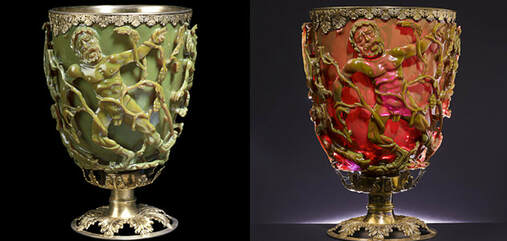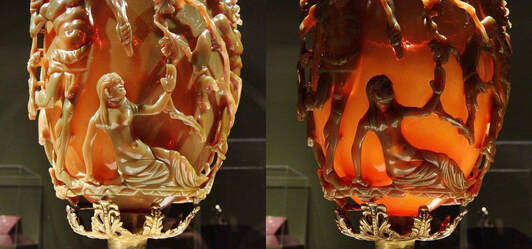|
Were the ancient Romans ahead of their time? The famous Lycurgus Cup in the British Museum might be proof that they were indeed very advanced in the sciences, especially in the field of Nanotechnology. The 1,600-year-old glass goblet does something very magical: It changes color from jade-green to blood-red depending on the direction of its illumination... with the light source from the front, the goblet appears green, from the rear it changes dramatically to red. This is called Dichroic behavior. The Roman craftsmen who created this work of art either knew about the science behind it, or stumbled unknowingly onto its special characteristics. As they might have put it, felix accidente, a happy accident. The Romans may have been the first to discover the colorful potential of nano-particles by accident, but they seem to have created the world's most perfect example of the phenomenon. The Artistry of the Chalice The Lycurgus Cup is also a very rare example of a Roman caged cup, or diatretum. The glass has been painstakingly cut and ground back to leave only a decorative "cage" on the surface with extreme undercutting. Instead of the more common abstract, geometric design, the Lysurgus Cup contains beautifully detailed human figures. It shows the mythical King Lycurgus, who attempted to kill Ambrosia, a follower of the god Dionysus (Bacchus). She was transformed into a vine that twined around the enraged king, killing him. Dionysus and two followers are shown taunting the king. Such figures on a caged cup are otherwise unknown. History of the Cup The Cup is thought to have been made in either Alexandria or Rome around 290-325 AD, measuring 6 1/2" x 5". Judging from its excellent condition, it more than likely was never buried and was always kept as a treasure, at first in a noble Roman's villa, then in a church and later in the collections of the elite. There is also the possibility that it was recovered from a sarcophagus. The gilt and bronze feet were added late in its life--about 1800, making some think it was looted from the church during the French Revolution. It's more than likely that earlier mounts existed, but wore away with time and use. No one really knows the earlier history of the Cup. One can ponder about who it was originally created for, perhaps an emperor? The Science Behind the Chalice: Dichroism The Lycurgus Cup was mentioned in French writings as early as the 1845, but no one knew why it changed color. The British Museum acquired the Cup in the 1950s, but it wasn't until 1990 that researchers examined small broken shards under an electron microscope and discovered the secret. Whether or not the Romans stumbled into it, the artisans were truly nanotechnology pioneers. Nano-particles of gold in the glass on a microscopic level is the reason for the color change. (Gold added to glass makes red glass, as in stained glass windows). It's unknown whether the Roman artisans impregnated the glass with particles of silver and gold on purpose, or whether the glass was somehow already "contaminated" before they used it. Researchers found particles as small as 50 nanometers in diameter, less than one-thousandth the size of a grain of salt. Some think that exact ratio of the mixture of the precious metals suggests the Romans certainly did know what they were doing. This is how the technology works: When hit with light, electrons belonging to the metal flecks reflect frequencies into our eyes in ways that alter the color depending on the observer’s position in relation to the light. Was the Lycurgus Cup a Poison Detector? During the Renaissance, the ruling class believed that goblets and glassware made on the island of Murano in the Venice lagoon would vibrate and shatter when poison was poured into them. Although false--and likely just marketing hype aimed at the ultra-rich so they would pay more for glassware--perhaps this long held notion was based in some long-distant reality... a capability of cups like the Lycurgus, perhaps? Gang Logan Liu, is an engineer at the University of Illinois at Urbana-Champaign, and has been focusing on using nanotechnology to diagnosis and treat disease. He explains, “The Romans knew how to make and use nano-particles for beautiful art. We wanted to see if this could have scientific applications.” Liu theorized that when a nano-treated vessel was filled with various liquids, the vibrating electrons would change the color of the glass according to the type of liquid used. The use the Lycurgus Cup to test his theory could never be allowed for fear of damaging a priceless Roman artifact. So he created this experiment: The scientists imprinted billions of tiny wells onto a plastic plate about the size of a postage stamp and sprayed the wells with gold or silver nano-particles, essentially creating an array with billions of ultra-miniature Lycurgus Cups. When water, oil, or sugar and salt solutions were poured into the wells, they displayed a range of easy-to-distinguish colors—light green for water and red for oil, for example. The prototype was 100 times more sensitive to altered levels of salt in solution than current commercial sensors using similar techniques. Were There Other Dichrioc Cups the Ancient World? Yes, it seems that the ruling class were well aware of them, owned them, gave them as gifts and drank from them on special occasions. However, only a handful of Roman dichroic glass objects are known to exist. Only 50 or so late Roman cage cups themselves exist, but even rarer, fewer than 10 dichroic glass objects have ever been found, and all of them (aside from the Lycurgus Cup) are mere fragments. Objects of such rarity with the extraordinary property of changing color would obviously be bought or commissioned by only privileged Romans. There are some ancient texts that discuss them... From Vopiscus' life of the third-century pretender Saturninus is a letter claimed to be written by emperor Hadrian (117–138) when he was in Egypt. Written in the early 4th century AD, Hadrian describes a gift to his brother-in-law Severianus in Rome: "I have sent you parti-colored cups that change color; presented to me by the priest of a temple. They are specially dedicated to you and to my sister. I would like you to use them at banquets on feast days" From the novel Leukippe and Cleitophon by Achilles Tatius (a second-century AD Alexandrian): The hero, Cleitophon, is at Tyre, where he attends a banquet given by his father on the feast day of Dionysus. During the meal, the host offers libations from an unusual vessel: "My father, wishing to celebrate it with splendor, had ... a precious bowl to be used for libations to the god ... Made of crystal... Vines crowned its rim growing from the cup itself, their bunches drooped in every direction. When the cup was empty, each grape seemed green and unripe, but when wine was poured into it, then little by little the clusters became red and dark, the green crop turning into the ripe fruit. Dionysus... was represented, near the bunches, as the husbandman of the vine and the vintner." Both of these texts describe very similar drinking vessels as the Lycurgus Cup. In the second text, you can imagine the cup from the drinker's perspective--filled with dark red wine, the outside of the cup was green. Then as the drinker lifts his glass and peers into it, the light passes through the side and it looks as if the grapes have turned red! The Lycurgus Cup was obviously a cup from Roman royalty that was treasured and cared for throughout the last 1600 years until modern scientists unlocked its secret. The Romans perhaps knew how to make and use nano-particles to create a beautiful object, but modern scientists think that nanotechnology can be useful in a wide range of scientific fields: chemistry, biology, physics, materials science, and engineering. Of course, perhaps equally amazing is the sheer beauty and artistry of the Lycurgus Cup. The capabilities of ancient Romans never cease to amaze me. --Jerry Finzi Watch the video below to see the changing colors... A beautiful example of A. J. Johnson’s 1866 map of Italy. Johnson first introduced this map in his 1863 atlas and it represents a substantial re-engraving of his original two part plate. Johnson's reconsideration of his Italy map was most likely related to Italy's unification in the 1860s. No longer a collection of independent states, Italy now needed to be represented as a cohesive whole. In order to accommodate this Johnson reorients his map to the northwest, allowing the boot to fill a single vertical page while leaving space to fully depict Sardinia and Corsica. In the lower right quadrant there is a inset map of Malta. Throughout, Johnson identifies various cities, towns, rivers and assortment of additional topographical details. Features the fretwork style border common to Johnson’s atlas work from 1864 to 1869. Published by A. J. Johnson and Ward as plate numbers 88 and 89 in the 1866 edition of Johnson’s New Illustrated Family Atlas .
At the beginning of 2017, we've started re-construction and re-organization of Grand Voyage Italy's pages. If you don't find what you are looking for on this new History page, use the Search Box to find what you need. Grazie!
|
On Amazon:
|










 RSS Feed
RSS Feed
